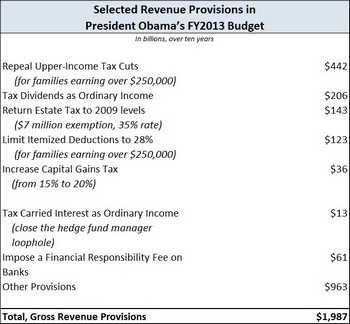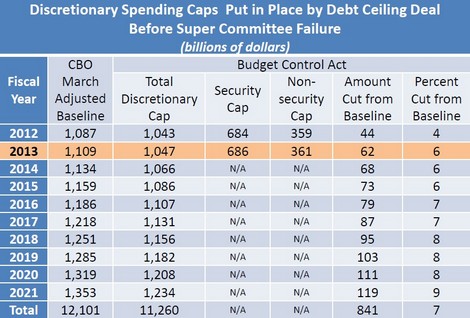
Is the President’s Budget Dead on Arrival? Maybe Not
2/22/2012
On Feb. 13, budget season officially began with the release of the president’s budget, which was immediately heralded as dead on arrival. “If there was ever a year to ignore the president’s annual budget proposal, this is it,” proclaimed the National Journal (subscription required). While this may be the fate of the president’s tax proposals, many of the program funding levels in his budget have a chance of becoming law.
In his budget for fiscal year (FY) 2013, Obama has proposed an ambitious agenda designed to highlight the differences between himself and his political opponents. At the forefront of this agenda is a slew of taxes on upper-income taxpayers, which are destined to face a very skeptical Congress.
The president’s revenue proposals are largely a resubmission of proposals from previous budgets (48 out of 61 of the president's revenue increases were in previous budget requests). He has again called for reinstating higher brackets on upper-income taxpayers, increasing the tax rate on capital gains and dividends, and restoring the estate tax to 2009 levels. The president reintroduced a previous proposal to tax large banks to pay for the bank bailout, but he doubled the size of the tax (to $61 billion) and would target the funds to mortgage relief. All told, the president’s budget contains almost $2 trillion in revenue raising proposals, with $1.6 trillion coming from upper-income individuals.

However, as the progressive tax group Citizens for Tax Justice has pointed out, these proposals leave $4.1 trillion in possible tax revenue on the table. The president would leave 78 percent of the Bush tax cuts in place. Restoring the estate tax to the 2009 level would short-circuit the scheduled return of the tax to 2001 levels (losing an estimated $433 billion in revenue).
Relative to what he could be asking for, the president’s tax proposals are quite moderate. They are also very popular among the public. A majority of Americans, including 54 percent of independent voters, support increasing taxes on capital gains and dividends, which Obama proposes. One poll found that more than half of Americans are in favor of two other Obama proposals – letting the upper-income Bush tax cuts expire and reducing the value of itemized deductions for the wealthy. And more than two-thirds of Americans support imposing higher taxes on millionaires, which this budget would most certainly accomplish. However, given the partisan gridlock in Congress, these revenue measures are unlikely to pass.
However, the president’s discretionary spending proposals – which comprise $1.3 trillion of his full FY 2013 $3.8 trillion request and fund the day-to-day operation of the federal agencies and thousands of programs such as national defense, homeland security, scientific research and development, environmental protection, disaster preparedness, tax collecting, and Wall Street oversight – have received much less criticism. None of the Republican leaders in the House or Senate criticized the president’s discretionary plans, instead focusing on the revenue and entitlement sections of the proposed budget.
In the past, with divided governance, the president and Congress usually fought over total discretionary spending levels but left the smaller details in the budget alone. This year, the president is attempting to avoid the fight over budget levels by sticking to the spending caps Congress agreed to in last summer’s debt ceiling deal, known as the Budget Control Act (BCA). These caps keep the overall discretionary spending levels about even with what they were in FY 2012, but the president has reprioritized some spending under the caps. Some programs would see moderate increases, and others would see cuts under the proposed budget. (More spending cuts are scheduled for the beginning of 2013, due to the failure of the Super Committee, but the president is proposing to offset these cuts with revenue increases and cuts to discretionary and war spending.)
As an example of the trade-offs occurring under the caps on discretionary spending, the president’s budget requests an increase of $16.7 million for food safety activities at the Centers for Disease Control and Prevention for research and monitoring of foodborne disease activities and to help with the implementation of the Food Safety Modernization Act. These investments could “help restore and improve state and local capacity to monitor foodborne illness and respond to outbreaks,” according to the agency. However, the National Institute for Occupational Safety and Health (NIOSH), responsible for recommending ways to prevent occupational disease and injury, is scheduled to receive a cut of over $43 million (15 percent of its FY 2012 budget).
[For more analysis on public protections funding in the president’s budget, see our recent report, Safeguarding the Public's Health and Safety.]
The president’s discretionary budget requests are more likely to be passed into law than his revenue measures because the overall level of discretionary spending has already been agreed to under the Budget Control Act, and the discretionary budget is less controversial than revenue measures or defense and entitlement program funding. While some conservative members of Congress are looking to cut spending levels below the Budget Control Act's caps, they will likely be held in check by their leaders. Earlier this week, Senate Minority Leader Mitch McConnell (R-KY) was quoted as saying, “Realistically, the [caps] are the best we’re going to be able to pass” this year. Additionally, The Washington Post recently reported that Republican budgeters in the House will use the president’s budget as the starting point for the yearly appropriations bills that fund the government. These factors, and the fact that the FY 2012 budget also followed the spending caps, indicate that some of the president's requests could survive the congressional budget process.



